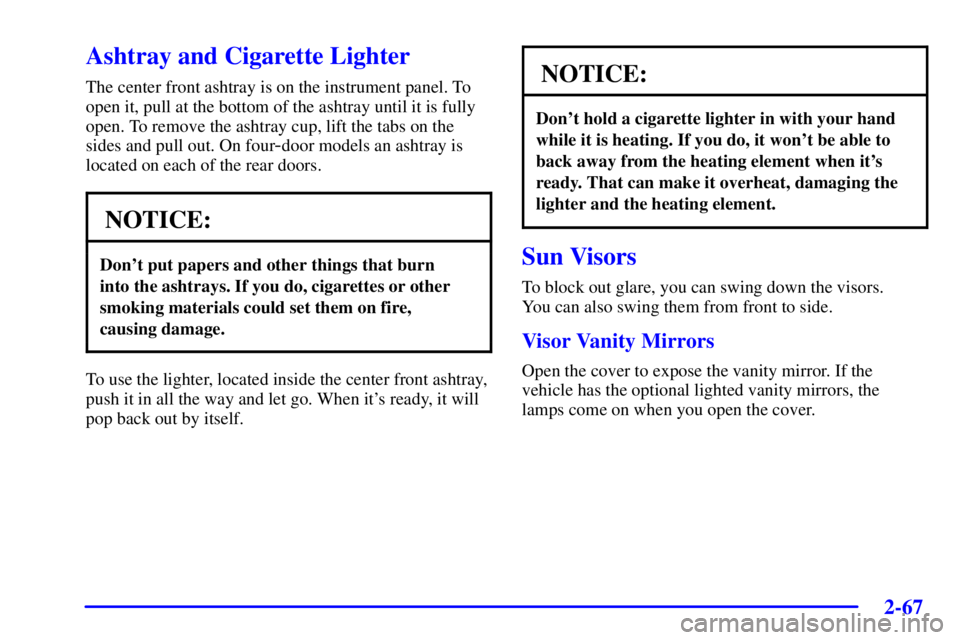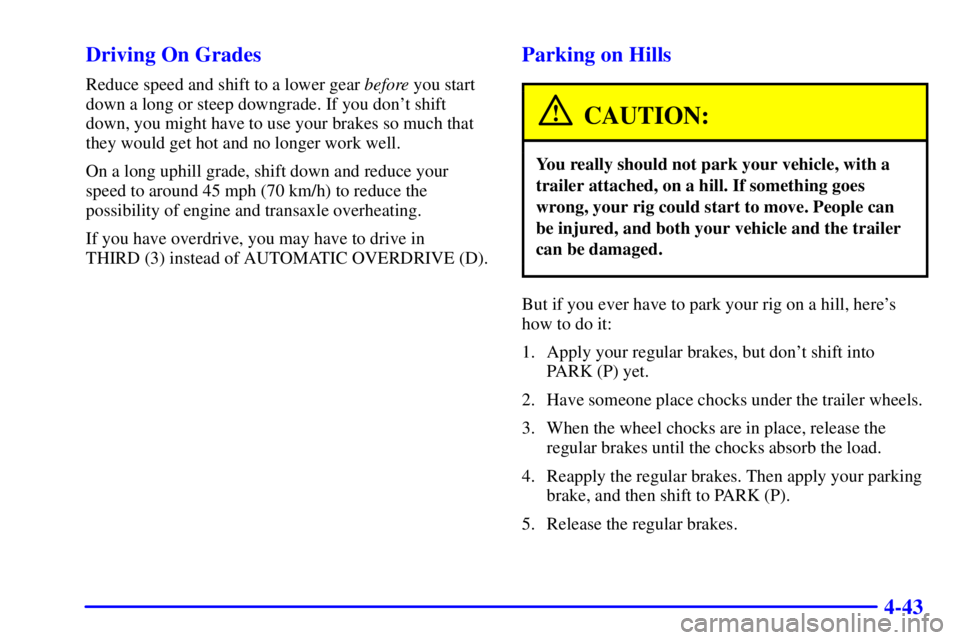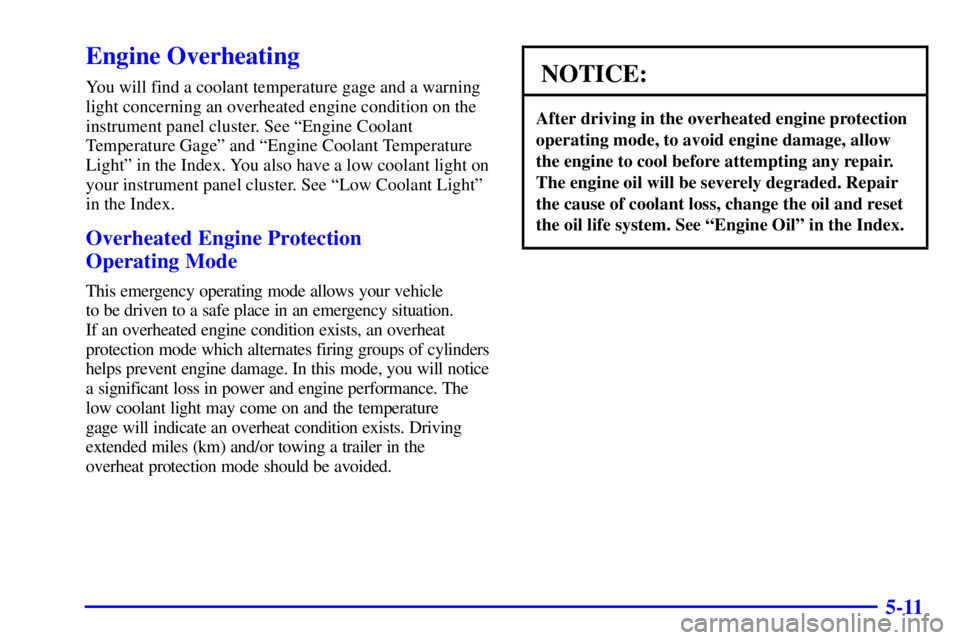Page 85 of 374

2-25
Trunk
CAUTION:
It can be dangerous to drive with the trunk lid
open because carbon monoxide (CO) gas can
come into your vehicle. You can't see or smell
CO. It can cause unconsciousness and even death.
If you must drive with the trunk open or if
electrical wiring or other cable connections must
pass through the seal between the body and
the trunk:
�Make sure all other windows are shut.
�Turn the fan on your heating or cooling
system to its highest speed with the setting
on VENT. That will force outside air into
your vehicle. See ªComfort Controlsº in
the Index.
�If you have air outlets on or under the
instrument panel, open them all the way.
See ªEngine Exhaustº in the Index.
Trunk Lock
To unlock the trunk from the outside, insert the key and
turn it clockwise. You can also press the trunk symbol
on the remote keyless entry transmitter (if equipped).
Remote Trunk Release
This feature is used to unlock the trunk from inside
the vehicle.
Press the TRUNK button
located behind the glove
box door.
The shift lever must be in PARK (P) for the remote
trunk release button to work.
Page 127 of 374

2-67
Ashtray and Cigarette Lighter
The center front ashtray is on the instrument panel. To
open it, pull at the bottom of the ashtray until it is fully
open. To remove the ashtray cup, lift the tabs on the
sides and pull out. On four
-door models an ashtray is
located on each of the rear doors.
NOTICE:
Don't put papers and other things that burn
into the ashtrays. If you do, cigarettes or other
smoking materials could set them on fire,
causing damage.
To use the lighter, located inside the center front ashtray,
push it in all the way and let go. When it's ready, it will
pop back out by itself.
NOTICE:
Don't hold a cigarette lighter in with your hand
while it is heating. If you do, it won't be able to
back away from the heating element when it's
ready. That can make it overheat, damaging the
lighter and the heating element.
Sun Visors
To block out glare, you can swing down the visors.
You can also swing them from front to side.
Visor Vanity Mirrors
Open the cover to expose the vanity mirror. If the
vehicle has the optional lighted vanity mirrors, the
lamps come on when you open the cover.
Page 143 of 374

2-83 Low Traction Light
If you have the Enhanced
Traction System or the
Traction Control System,
this light will also come
on when the system is
limiting wheel spin.
You may feel or hear the system working, but this is
normal. Slippery road conditions may exist if the low
traction light comes on, so adjust your driving
accordingly. The light will stay on for a few seconds
after the Enhanced Traction System or the Traction
Control System stops limiting wheel spin. See
ªEnhanced Traction Systemº or ªTraction Control
Systemº in the Index.
The low traction light also comes on briefly when you
turn the ignition key to RUN. If the light doesn't come
on then, have it fixed so it will be there to tell you when
the Traction Control System or Enhanced Traction
System is active.
Engine Coolant Temperature Light
This light tells tells you that
the engine coolant has
overheated or the radiator
cooling fan is not working.
If you have been operating the vehicle under normal
driving conditions, you should pull of the road, stop the
vehicle and turn off the engine as soon as possible.
See ªEngine Overheatingº in the Index.
Page 144 of 374
2-84
Engine Coolant Temperature Gage
United States Canada
Your vehicle has a gage that shows the engine coolant
temperature. If the gage pointer moves into the shaded
area, the engine is too hot.
That reading means the same thing as the warning light.
It means that the engine coolant has overheated. If you
have been operating the vehicle under normal
conditions, you should pull off the road, stop the
vehicle, and turn off the engine as soon as possible.
See ªEngine Overheatingº in the Index.
Low Coolant Warning Light
If this light comes on,
the system is low on
coolant and the engine
may overheat.
See ªEngine Coolantº in the Index and have the vehicle
serviced as soon as possible.
Page 163 of 374

3-4
Heating
On cold days select a fan setting and use floor with the
temperature levers all the way in the red area. The
system will bring in outside air, heat it and send it to the
floor ducts.
If your vehicle has an engine coolant heater, you can use
it to help your system provide warm air faster when it's
cold outside 0�F (
-18�C) or lower. An engine coolant
heater warms the coolant your engine and heating
system use to provide heat. See ªEngine Coolant
Heaterº in the Index.
Ventilation
For mild outside temperatures when little heating
or cooling is needed, use a fan setting and vent with
the A/C button off, to direct outside air through
your vehicle.
Defogging and Defrosting
Your system has two settings for clearing the front and
side windows. To defrost the windows quickly, turn the
fan to a high setting and use defroster with the
temperature levers all the way in the red area. To
warm passengers while keeping the windows clear,
use defogger.
Rear Window Defogger
The rear window defogger uses a warming grid to
remove fog from the rear window.
The comfort control
system has a button to
operate your vehicle's
rear window defogger.
It is marked REAR.
Press the button to turn the rear window defogger on or
off. When the rear window defogger is operating, an
indicator above this button will light. The rear warming
grid will turn off after about 15 minutes.
If you turn the rear window defogger on again, it will
operate for about seven and one half minutes before
turning off. The system will turn off when the ignition is
turned off.
Do not attach anything like a temporary vehicle license
or decal across the rear window defogger grid.
Page 223 of 374

4-43 Driving On Grades
Reduce speed and shift to a lower gear before you start
down a long or steep downgrade. If you don't shift
down, you might have to use your brakes so much that
they would get hot and no longer work well.
On a long uphill grade, shift down and reduce your
speed to around 45 mph (70 km/h) to reduce the
possibility of engine and transaxle overheating.
If you have overdrive, you may have to drive in
THIRD (3) instead of AUTOMATIC OVERDRIVE (D).
Parking on Hills
CAUTION:
You really should not park your vehicle, with a
trailer attached, on a hill. If something goes
wrong, your rig could start to move. People can
be injured, and both your vehicle and the trailer
can be damaged.
But if you ever have to park your rig on a hill, here's
how to do it:
1. Apply your regular brakes, but don't shift into
PARK (P) yet.
2. Have someone place chocks under the trailer wheels.
3. When the wheel chocks are in place, release the
regular brakes until the chocks absorb the load.
4. Reapply the regular brakes. Then apply your parking
brake, and then shift to PARK (P).
5. Release the regular brakes.
Page 224 of 374

4-44 When You Are Ready to Leave After
Parking on a Hill
1. Apply your regular brakes and hold the pedal down
while you:
�start your engine,
�shift into a gear, and
�release the parking brake.
2. Let up on the brake pedal.
3. Drive slowly until the trailer is clear of the chocks.
4. Stop and have someone pick up and store the chocks.
Maintenance When Trailer Towing
Your vehicle will need service more often when you're
pulling a trailer. See the Maintenance Schedule for more
on this. Things that are especially important in trailer
operation are automatic transaxle fluid (don't overfill),
engine oil, drive belts, cooling system and brake system.
Each of these is covered in this manual, and the Index
will help you find them quickly. If you're trailering, it's
a good idea to review this information before you start
your trip.
Check periodically to see that all hitch nuts and bolts
are tight.
Engine Cooling When Trailer Towing
Your cooling system may temporarily overheat during
severe operating conditions. See ªEngine Overheatingº
in the Index.
Page 235 of 374

5-11
Engine Overheating
You will find a coolant temperature gage and a warning
light concerning an overheated engine condition on the
instrument panel cluster. See ªEngine Coolant
Temperature Gageº and ªEngine Coolant Temperature
Lightº in the Index. You also have a low coolant light on
your instrument panel cluster. See ªLow Coolant Lightº
in the Index.
Overheated Engine Protection
Operating Mode
This emergency operating mode allows your vehicle
to be driven to a safe place in an emergency situation.
If an overheated engine condition exists, an overheat
protection mode which alternates firing groups of cylinders
helps prevent engine damage. In this mode, you will notice
a significant loss in power and engine performance. The
low coolant light may come on and the temperature
gage will indicate an overheat condition exists. Driving
extended miles (km) and/or towing a trailer in the
overheat protection mode should be avoided.
NOTICE:
After driving in the overheated engine protection
operating mode, to avoid engine damage, allow
the engine to cool before attempting any repair.
The engine oil will be severely degraded. Repair
the cause of coolant loss, change the oil and reset
the oil life system. See ªEngine Oilº in the Index.